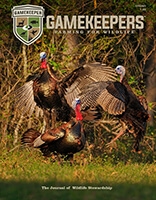What hunting tactics come to mind when it comes thinking about hunting small properties? I’ve always resorted to the conventional wisdom of erring on the side of caution and leaving a small footprint. I think of permanent stands over food sources, established access trails, and a rigid adherence to conditions-appropriate hunting. This ideology works and often allows you to find success on small properties, but there is only one problem, mature bucks can be squirrelly and don’t always follow the script—especially if they sense a little pressure.
Harvesting deer on a small property is one thing, but finding and tagging a mature buck is another. When it comes to pursuing this endeavor, you often have to think outside of the box. Sometimes the conventional wisdom of sitting and waiting isn’t the best option. I feel that occasionally you have to take some chances and dive in. I’m talking about a more aggressive mobile hunting approach.
What exactly is mobile hunting? In the most basic terms, mobile hunting is the practice of using lightweight, mobile hunting gear to hunt a new setup every hunt. There is no hunting a preset location over and over again with this approach. It’s a good way to follow the deer and hunt the freshest sign possible. Bucks aren’t always going to visit your permanent stand locations—mobile hunting makes it easier for you to go to them.
I practice mobile hunting on public land exclusively but have starting implementing it on my private land hunts as well. The farm that I hunt has four well-established food plot setups that provide us with great hunts every year, but there is a lot of good hunting that happens between those spots. I’ve been fortunate enough to capitalize on some of my mobile hunts over the last few seasons with firearm and archery tackle. And I’ve also been able to harvest bucks that I more than likely wouldn’t have been able to take while waiting at a permanent stand setup.
I encourage every hunter to practice mobile hunting if possible. It’s a thrilling way to hunt and often can be the missing piece you need to find success, even if you have put a lot of time and resource into land management. However, mobile hunting isn’t necessarily an easy endeavor. There is plenty of nuance here; creativity and attention to detail are both needed to pull of these hunts. If you are interested in giving mobile hunting a try on your small property, there are a few questions that you need to ask yourself.
Would I Benefit from Mobile Hunting?
There is a multitude of reasons why a hunter would benefit from a mobile hunting approach. First, it allows you to go closer to the deer as opposed to waiting on the deer to come to you. This allows you to make adjustments, follow the freshest sign, and work within the parameters of daylight deer movement. Secondly, you will be able to catch deer by surprise. Mistakes made in a permanent stand could come back to haunt you for the entirety of the season. Mistakes made during a mobile hunt can be erased tomorrow by hanging a new set elsewhere. And lastly, mobile hunting allows you to adapt to current conditions. Most permanent sets are designed for a specific wind direction. This isn’t a deal breaker for mobile hunters because each setup can be fine-tuned to accommodate the conditions.
If any of the previously mentioned advantages sound good, mobile hunting may be for you. However, it would be irresponsible to only discuss the advantages. There are a few nuances that need to be overcome if you decide to pursue mobile hunting. Mobile hunting can be expensive to get into considering the amount and type of gear needed. This can be a major deterrent. Also, mobile hunting is work. Hauling your stand, saddle, or climbing sticks in and out of the woods every hunt definitely burns calories. If you are the type of hunter that enjoys a leisurely walk to a box blind with only a small backpack, mobile hunting might not be for you.

Mossy Oak
Is My Property Set Up Right for Mobile Hunting?
If you’ve determined that you want to give mobile hunting a chance on your small property, you then have to figure out if the property is set up appropriately. I’ve developed a secondary set of questions to ask yourself to determine this.
First, I’d ask “are my permanent stand setups accomplishing my goals?” If the answer is “no,” then a mobile hunting approach may be your answer. Like I mentioned earlier, permanent setups are usually good for only one condition or one presentation and often aren’t versatile. And if you’ve hunted small properties before, you would know that there are usually not many spots for a permanent stand setup. This leaves your hunting options to a minimum. Mobile hunting helps create a multitude of options.
Next, I ask “does the property have something to offer the deer?” While mobile hunting creates a number of options, it is also necessary for the property to have attractions for the deer—a reason for the deer to be there. If your property is a big open hay field where deer cross occasionally and no cover is present, then your options are few anyway. But if the property has a good mix of natural mast, planted food, and decent bedding cover than your mobile hunting options are many. The more the diverse a small property is, the better.
Lastly, I ask “am I able to access my hunting spots efficiently?” In other words, can I get to my spot without alerting deer? This goes for all types of hunting approaches. Access is everything, but because mobile hunting usually requires you to get a bit closer to the deer, access is even more important. Great mobile hunting access can be created through variable topography, dense cover, and good downwind approaches. Basically, you want to avoid eyes, ears, and nose at all times.
If your answers to all of these questions point towards mobile hunting, you can start establishing your gear setup.

Will Bowen
Which Mobile Hunting Setup is Best?
There are several different directions you can go here and still maintain good mobility and versatility. The key is to find a setup that works well in the habitat that you hunt, fits your fitness and comfort needs, and stays within your budget. I’ve seen and used the three following mobile hunting setups. See which one sounds best for you.
First, we have the climbing stand. Growing up in the south amongst the mature oak river bottoms and the tall pine thickets in the hills allowed me to get used to a climbing stand quickly. In woods where the trees grow tall, straight, and without many low limbs, it’s hard to beat a climbing stand. They are great for quickly scaling trees and providing maximum comfort for all day sits. However, if the property that you hunt is covered in dense brush, crooked trees, or has a low canopy, a climbing stand will be very, very limiting.
Second, we have the hang-on stand and climbing stick combination. I quickly made this setup when I moved to Missouri. The Ozark woods called for it. A hang-on stand and climbing stick combo is more complex than a climbing stand, considering there are multiple pieces to the setup as opposed to one (stand, climbing sticks, aiders, etc.). But because of that complexity, this setup is more versatile and can be used in a variety of trees that you wouldn’t even think about putting a climber in. This also allows you find the tree with the best hide for your stand.
The last option we’ll look at is the climbing stick and tree saddle combination. This setup is similar to the last, with a hang-on being swapped out for a tree saddle. There is a big difference here too. A tree saddle will easily get you the lightest setup out there, if that is something that is important to you. It is also the most complicated setup considering the saddle consists of multiple tethered components. While being too complicated for some hunters to concern themselves with, a tree saddle and stick combination probably offers the most versatility and best hide advantage when compared to the other two options, in my opinion.
One setup is not necessarily better than the other. Like I stated earlier, it’s about finding the one that works best for you. If you enjoy simplicity and you have the appropriate habitat to hunt it would be really hard to beat a simple climbing stand. If you don’t mind a more complicated setup and are wanting to dive into some of the most difficult to navigate habitat on the property, then a saddle or hang-on option might be better for you. In a perfect world you may be able to find a hunting buddy that would let you try out his mobile hunting gear before you purchase your own.
Tips for Mobile Hunting on Small Properties
The following is a list of tips to aid in your mobile hunting pursuits:
- Know your gear setup well and be well practiced in its use. If you’ve decided that a climbing stick and saddle setup is your best tool, then I would encourage you to at least have several dozen climbs before hunting the first time. Practice shooting from the saddle. The goal here is to improve safety and speed. As everything seems to be in hunting, mere minutes make a huge difference.
- Scout every time you hunt and adjust accordingly. When you are proceeding into the woods and moving closer to the deer, you see things you otherwise wouldn’t have seen. You see those fresh scrapes and rubs that were out of eyesight of your food plot set-up. You see those tracks and droppings around the mast tree that you didn’t know existed. Pay attention to these things every outing and you will be able to make the proper adjustments.
- Consult digital maps regularly. When hanging and hunting new setups constantly, it is important to stay in tune to what is around you. It also allows you to see the whole picture and put things into perspective. Using services like OnX or DeerCast Maps helps you see the forest through the trees.
- Don’t get lazy with access. Just because you are hanging and hunting a new setup every time doesn’t mean that your careless entry won’t affect you later. I would say that in mobile hunting, stellar access is even more important. We are trying to hunt where deer are now, and that means you have to use every advantage to make sure the deer don’t know that you are there.
- Get in early and come out late. This goes hand in hand with stellar access. Being there early and leaving late ensures that deer aren’t alerted and that you are where you need to be when the moment of truth comes. Every situation is different, but you want must make sure you don’t telegraph your intentions or introduce more pressure than necessary.
Mobile hunting isn’t for everyone and hunting small properties isn’t for everyone either. It can be challenging for sure, but if you are willing to give it a try, a whole new level of deer hunting can be opened to you. Ask yourself the questions above. Is this what you want? If the answer is yes, I say go for it. Hopefully this information helps you get started on your mobile hunting journey!
-
Join our weekly newsletter or subscribe to Gamekeepers Magazine.
Your source for information, equipment, know-how, deals and discounts to help you get the most from every hard-earned moment in the field.









